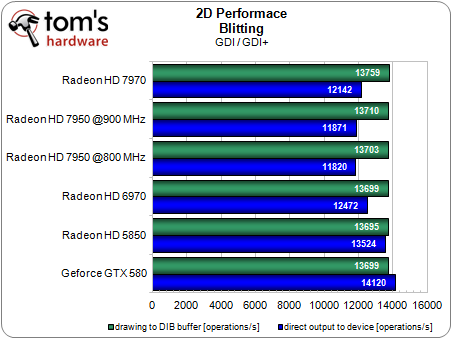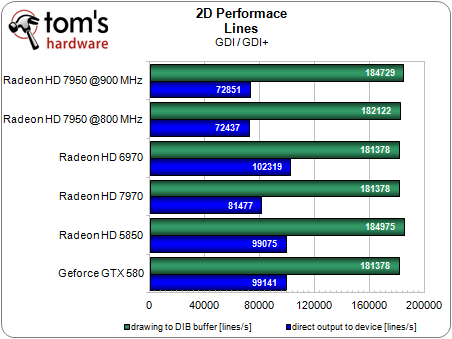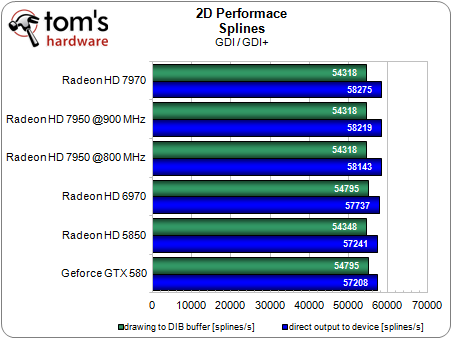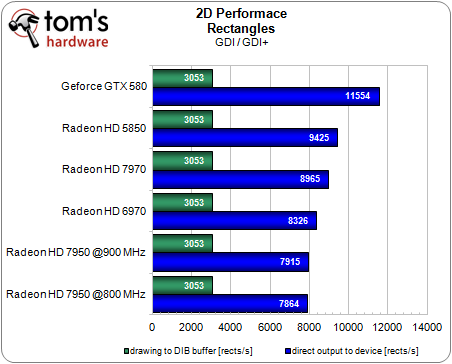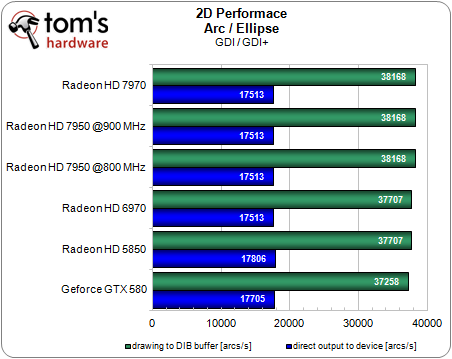AMD Radeon HD 7950 Review: Up Against GeForce GTX 580
2D Performance Via GDI And GDI+
While it may not be as sexy as 3D performance, 2D rendering is still important. While there is a clear trend towards rendering 2D content using Microsoft’s more modern Direct2D API, it’s a safe bet that more than 90 percent of all applications in use today still rely on the drawing functionality provided by the older GDI (Graphics Device Interface) and GDI+. Most user interface elements, such as frames, buttons, and toolbars, are rendered using these components, though. Meanwhile, older programs created for very specific purposes rely completely on this rendering method for all of their 2D objects. That’s why we decided to test 2D performance as well.
Text Output
As in our Radeon HD 7970 coverage, the two Tahiti-based cards are the only ones that stumble with regard to direct (hardware-accelerated) output to the display, and not buffered and unaccelerated output in the form of a DIB (device-independent bitmap). It looks like nothing has changed in this metric since we tested with the launch driver.
Again, it’s unlikely that this score will result in a tangible real-world performance hit. However, it’s interesting that the older Radeons do a lot better. Our guess is that hardware acceleration for direct text rendering is still immature, since that score is even slower than the non-accelerated software solution using a DIB. Obviously, a little driver tweaking is in order, even if we're using the third driver revision seen since the 7970's debut.
The Radeon HD 7950 only achieves half of the text output of a Radeon HD 6970, putting it on par with the integrated GeForce 7025 GPU found in Nvidia's aging nForce 610i chipset.
Image Manipulation
Surprisingly, the Radeon HD 7950 is faster than the 7970 in our stretching test's direct output mode, reaching scores similar to those of the Radeon HD 6970. At the same time, we see that the cards perform better in software mode across the board.
Get Tom's Hardware's best news and in-depth reviews, straight to your inbox.
Meanwhile, simple copy operations (blitting) show very little variation between cards, and only the GeForce GTX 580 is faster taking the direct route than using the detour through the buffer (a clear sign that hardware acceleration is being used more efficiently). Once again, AMD’s software implementation of this previously hardware-accelerated feature still needs some work.
Geometry Performance
Both the Radeon HD 7970 and 7950 fall behind by a small margin when drawing lines. The remainder of our benchmarks show all of the contenders performing quite similarly, though.
Both splines and rectangles are apparently accelerated quite well when they are rendered sequentially, since the direct output path is faster than the software version in either case. This performance delta is especially apparent in the triangles test. The exact opposite applies when it comes to drawing polygons, where buffered output is much higher.
AMD has certainly improved its drivers since the first time we took a closer look at 2D performance, though the Radeon HD 7900s continue falling behind previous-generation boards when tasked with hardware-accelerated text output, achieving half the performance of older cards. Stretching and drawing lines could also be faster on the new cards.
Now, in context, it’s unlikely that you’d notice any visible slow-downs in everyday tasks. The lower performance could become apparent when you move longer pieces of floating text in programs like Corel 14. The 2D situation is much-improved compared to what we saw when the Radeon HD 5870 launched, but it still needs some work.
Current page: 2D Performance Via GDI And GDI+
Prev Page Benchmark Results: vReveal Next Page CrossFire And SLI: 3DMark 11-
Im not Paying $450 for barely better then GTX 580 performance a year after its released. They will have to knock that down to like $300, $250 for a 2gb version when Nvidia releases their next gen cards. Wait those money grubers out imo.Reply
-
thesnappyfingers stm I was thinking the same thing. But then agian it is still cheaper, more efficient compared to the gtx 580. Still, I am waiting it out till kepler.Reply -
rmpumper 7950/7970 should be priced ~$50+ of 6950/6970 prices. So as it is now, if nvidia's gtx680 will be better than 7970 they will price it at >$600? That's a load of crock.Reply -
Derbixrace great value compared to the 7970 because you can OC it to be faster than it on stock voltage and even further with voltage tweaking ;)Reply -
esrever I'd love to have one once kepler comes and these drop in price. Im gonna start saving.Reply -
It beats the GTX580 one on one in most benchies and that's not taking into account the overclocking headroom these things have, they're also power friendlier and with XFX, cooler, quieter and expected to be cheaper so what's the problem? Me thinks me smell's NV fanboys!!Reply
-
dragonsqrrl rmpumper7950/7970 should be priced ~$50+ of 6950/6970 prices. So as it is now, if nvidia's gtx680 will be better than 7970 they will price it at >$600? That's a load of crock.Every rumor and leak I've seen so far on gk104 pricing seems to indicate otherwise...Reply
http://www.guru3d.com/news/nvidia-gk104-kepler-gpu-priced-at-299-230-/
According to Nvidia's AIB partners the initial price set for the first gk104 based graphics card is $300. Of course this can go up or down based on the competition. Unfortunately, I have the feeling it'll be going up.


